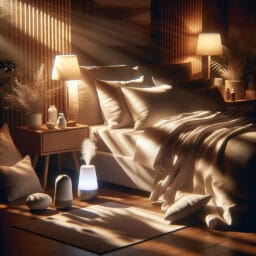
Maximizing Rest: Essential Sleep Optimization Tips for Middle-Aged, Socially Active Adults
Table of Contents
- Introduction
- Understanding Sleep and Its Impact on Health
- Common Sleep Disturbances Among Middle-Aged Adults
- Essential Sleep Optimization Tips
- Navigating Social Obligations and Sleep
- When to Seek Professional Help
- Conclusion
- Frequently Asked Questions
Introduction
Did you know that as we grow a bit older, our snooze time can get a little wonky? Yep, it’s true! Middle-aged folks often find their sleep isn’t quite as sweet as it used to be. You see, our bodies love rhythm and predictability, but life sometimes plays a wild card – hello, sleep apnea and restless nights!
Now let’s talk turkey about getting those zzz’s back on track. It’s not just about counting sheep; there are science-backed tricks to make sleepytime more awesome. Ever heard of cognitive behavioral therapy for insomnia (CBT-I)? It’s like a personal coach for your sleep routine. A sleep specialist might suggest CBT-I if you’re having a tough time catching those precious winks.
Here’s another hot tip: keep a sleep diary. Jot down when you nod off, wake up, and any midnight adventures to the fridge or bathroom. A systematic review of these notes can reveal patterns you never knew were messing with your shut-eye.
And hey, you’ve gotta move it to snooze it! Physical activity during the day can help tire you out in the best way so that when bedtime rolls around, your body is ready to fall asleep without doing somersaults under the covers.
Still tossing and turning? Maybe it’s time to meet with a sleep medicine specialist who understands exactly what older adults need for good sleep quality. They know all about those sneaky internal alarm clocks (a.k.a. sleep cycles) and how they change over time.
So whether it’s fine-tuning your environment for prime dozing conditions – think cool room, dark curtains – or figuring out how to fall back asleep when stress tries to barge into dreamland at 3 AM, improving sleep quality isn’t just dreamy talk; it’s totally doable! Grab that cozy blanket and fluff up the pillow; beautiful slumber awaits after tailoring that perfect nighttime dance between the sheets – aiming for top-notch sleep hygiene.
Understanding Sleep and Its Impact on Health
Wondering how that cozy blanket and perfectly fluffed pillow actually translate into quality snoozing? Let’s unwrap the science of slumber. You see, sleep is a complex ballet performed in various stages – from light dozing to deep REM (Rapid Eye Movement) dreams. What many don’t realize is that as we hit middle age, our internal clock, known as our circadian rhythm, often gets a bit out of sync. This means older adults might have a harder time falling asleep and staying asleep, leading them to wake up feeling like they’ve run a marathon instead of having been nestled in bed.
Good sleep goes beyond closing our eyes; it’s an essential service for the body, repairing muscles and consolidating memories from the day. Poor sleep? Well, think of it as your body missing out on vital maintenance. It’s no wonder then that when sleep apnea barges in or stress knocks at the door of your mind in the wee hours, you’re left grappling with poor sleep quality.
The role of cognitive behavioral therapy (CBT) here cannot be underestimated. Tailored specifically for insomnia among older adults, CBT focuses on challenging and changing unhelpful cognitive distortions and behaviors, improving emotional regulation, and developing personal coping strategies targeting solving current problems related to sleep issues.
Physical activity also deserves a standing ovation for its part in promoting good sleep hygiene. A brisk walk or a fun dance class during the day isn’t just about keeping fit; it’s also about tiring out your body so you can fall back asleep faster if night-time wakefulness strikes.
And let’s not forget about the systemic review of one’s daily routine through maintaining a detailed sleep diary. Sometimes spotting what’s disrupting your rest can be eye-opening! It could be that cup of Joe after dinner or an overstimulating evening news program setting off alarms in your brain right before bed.
As you navigate the seas of middle-aged slumber, always remember there are skilled navigators ready to help: enter the sleep medicine specialist! They’re equipped with knowledge on everything from optimizing your bedroom environment to navigating those pesky changes in sleep cycles that come with age.
So while we all wish for uninterrupted eight-hour journeys into dreamland every night, achieving this involves more than wishful thinking—it requires understanding and working with our ever-changing bodies to maintain optimal health and improve sleep quality amidst life’s second act challenges.
| Aspect of Sleep | Description | Relevance to Health |
|---|---|---|
| Circadian Rhythm | The body’s internal clock that regulates the sleep-wake cycle. | Disruptions can lead to difficulty falling and staying asleep, especially in middle age. |
| Sleep Stages | Includes light sleep, deep sleep, and REM sleep. | Each stage plays a role in bodily repair and memory consolidation. |
| Sleep Disorders | Conditions like sleep apnea can severely impact sleep quality. | Poor sleep quality can affect overall health and daily functioning. |
| Cognitive Behavioral Therapy (CBT) | A therapy approach targeting the cognitive and behavioral aspects of insomnia. | Helps improve sleep patterns and emotional regulation related to sleep. |
| Physical Activity | Engaging in exercise to promote fatigue and readiness for sleep. | Can help improve the speed of falling asleep and the ability to return to sleep after waking at night. |
| Sleep Diary | A detailed tracking of daily sleep habits and routines. | Identifying and modifying disruptive habits can significantly improve sleep quality. |
| Sleep Medicine Specialist | A healthcare professional specializing in sleep and its disorders. | Can provide tailored advice and treatment options to improve sleep in middle age and beyond. |
Common Sleep Disturbances Among Middle-Aged Adults
Did you ever stop to think that the golden years might have a silver lining? Well, not when it comes to sleep! A whopping one in three middle-aged adults wrestles with insomnia—a pesky nighttime nemesis that can turn counting sheep into an epic quest. But fear not! With a little know-how and some tweaks to your routine, you can reclaim the kingdom of nod.
Let’s shine a spotlight on two noisy culprits: sleep apnea and snoring. These are more than just midnight nuisances for older adults; they’re like little gremlins disrupting sleep quality by blocking airways and turning peaceful nights into loud, gaspy performances. Tackling these with help from a trusted sleep specialist could be your ticket back to silent nights and sweet dreams.
Now twirl over here where Restless Leg Syndrome (RLS) and Periodic Limb Movement Disorder (PLMD) are doing the jitterbug in too many bedtime stories. These conditions cause involuntary leg twitching or jerking, ruining any hopes of smooth sailing through dreamland. But don’t fret—scheduling a dance-off with your doctor could lead to effective treatments that let your legs chill out at night.
And let’s chat about lifestyle choices because believe it or not, what you do during daylight hours plays encore at night. Sipping on caffeine late in the day or staring at screens before bed is like throwing a party for your brain when it should be winding down. Cut these out for better zzz’s!
Good sleep hygiene isn’t rocket science—it’s more like being a detective in your own life story. Keep that sleep diary nearby so you can spot clues about what helps you fall asleep faster and what makes falling back asleep feel impossible.
Need extra backup? Cognitive behavioral therapy (CBT) isn’t only for daytime worries; it works wonders for nighttime troubles too by teaching practical skills to improve sleep quality without counting endless sheep.
Remember those days when physical activity meant tagging along after the kids all day? Well, staying active keeps being important as we age—it tires us out in just the right way so we can fall back asleep like a log after any unexpected wake-ups.
In between these strategies, consider if there’s room to refine your whole sleep routine—from dusk till dawn—with fresh eyes focused on getting back those blissful eight-hour voyages across slumberland seas every single night. So fluff up those pillows and get ready to embark on a voyage toward serene slumbers—you’ve got this!
Essential Sleep Optimization Tips
Did you know that the type of mattress and pillows you use can be the unsung heroes of your sleep saga? As we sail into middle age, our bodies often require a softer landing pad to ease those achy muscles and joints. To keep your bedtime as inviting as a warm hug, hunt down a mattress that supports you just right, like finding the perfect dance partner for a smooth waltz through dreamland. And don’t skimp on those pillows! They should cradle your neck and head like gentle clouds, keeping everything aligned so you can drift off without a care.
Now, let’s talk about setting the scene with light and temperature. Your bedroom should be an oasis of calm with dim lighting that whispers ‘relax’ to your brain. Installing blackout curtains could very well be your ticket to blissful nights, blocking out any pesky streetlights or moonbeams that try to sneak in. And temperature? Imagine your room as a cool cave where sleep is king—around 65 degrees Fahrenheit is usually just right for most sleepy sailors.
Ever thought about the symphony of sounds around you at night? Noise control is no joke when it comes to quality sleep, folks! A white noise machine might just become your new best friend by drowning out those distracting jingles and jangles from outside or down the hall. It’s like smoothing over ripples on water—steady, soothing sounds help lull you into slumber land.
Let’s chew on this: what you eat affects how fast you fall asleep and how solidly you stay there. That late-night snack attack? Pick wisely; some foods are like secret lullabies for your tummy. Cherries, for instance, are chock-full of melatonin—the body’s sleep regulator. On the other hand, avoid heavy meals too close to bedtime; they’re more likely to cause tossing than tranquility.
Exercise isn’t only good for daytime derring-do—it also plays an encore at night by improving sleep quality. Just remember: timing is key! Engaging in physical activity too late can rev up your engine instead of winding it down. Aim to get moving earlier in the day so when it’s time to catch some zzz’s, you’re ready to fall back asleep without performing acrobatics under the covers.
And before we say “nighty-night,” let’s not forget about managing stressors big and small with relaxation techniques that make waves in all the right ways. Ever tried mindfulness meditation? Picture yourself floating on calm waters as worries slip away… Now that’s good stuff for prepping mind and body for Morpheus’ embrace!
So gather up these precious pearls of wisdom—fine-tune that pre-sleep routine with strategies steeped in self-care—and watch how these tide changes invite smoother sailing into slumberland each evening!
Navigating Social Obligations and Sleep
Imagine the social butterfly of middle age, flitting from event to event, each evening alive with laughter and conversation. The buzz is electric—a joy for sure—but can it mess with our shut-eye? Absolutely! Managing a vibrant social life while keeping sleep sacred is an art form in itself. Here’s a fresh scoop: successful sleep doesn’t mean skipping out on fun; it’s about syncing your social clock with your body’s natural rhythms.
Take note, party-goers and night owls! When late-night invites come calling, strategize like a sleep specialist on a mission. Plan for power naps earlier in the day to prep for extended evenings. A short 20-minute snooze can recharge those batteries without dipping into deep sleep cycles that leave you groggy.
Now let’s talk boundaries—yes, they’re not just for daytime dilemmas! Communicating your sleep needs might seem like a snore fest at first, but hey, good pals get it. They’ll rally around your quest for quality zzz’s because they want you bright-eyed for the next shindig. It’s all about balance; enjoy the limelight but also know when to slip away and embrace the hush of night.
Here’s a quirky idea: host events that wrap up well before Cinderella’s deadline. You become the trendsetter for soirées that respect the sandman’s schedule—how cool is that? Plus, equipping yourself with knowledge from a systematic review or two about good sleep hygiene could turn you into the go-to advisor among your crew!
Ever heard of cognitive behavioral therapy (CBT)? It’s not only handy for stress and worries—it works wonders when learning how to fall asleep after an adrenaline-filled evening. Techniques learned here aren’t just fluff; they’re proven ways to help you fall back asleep fast even after the most energetic salsa dance.
Finally, don’t forget to bookend active nights with serene mornings or soothing evenings whenever possible. Embrace rituals that whisper calmness: maybe yoga at dawn or herbal tea as twilight fades. This way, your body and mind sync up beautifully for a slumber as refreshing as an ocean breeze—even if last night was all about living it up under the disco lights!
When to Seek Professional Help
Ever felt like you’re running on fumes, with your sleep tank on empty? It might be time to wave the white flag and seek professional advice. Recognizing the signs that you need a helping hand from a sleep specialist can be a game-changer for those enduring poor sleep, yet it’s often overlooked by busy middle-aged adults. If your own efforts to improve sleep quality aren’t cutting it—maybe you’ve tried all the sleepy teas and sheep counting possible—it’s probably time to consider expert help.
When visiting a sleep medicine specialist, expect more than just a chat about snooze patterns. These pros dive deep, investigating everything from your nightly routines to underlying health issues that could be causing disturbances in your sleep cycle. They might recommend keeping a detailed sleep diary as part of a systematic review or conducting overnight studies to witness firsthand what goes bump in the night within your body.
For those who find themselves staring at the ceiling well past bedtime, cognitive behavioral therapy (CBT) emerges as an effective treatment; it’s not just buzzwords but science-backed strategy. CBT helps rewires the brain’s faulty bedtime stories into scripts that encourage falling asleep faster and more soundly. And for conditions like sleep apnea—a real bear of an issue for many older adults—sleep specialists may prescribe continuous positive airway pressure (CPAP) machines or suggest lifestyle changes that can make significant dents in improving sleep quality.
So if playing lullabies and cooling down the bedroom haven’t nudged you back into dreamland, don’t fret! There are numerous paths and professionals eager to guide you towards reclaiming those precious Z’s. From simple adjustments recommended through a thorough consultation to potential treatments like CBT, there’s hope on the horizon for turning those restless nights into peaceful slumber fests again.

Conclusion
Let’s zoom out for a moment – did you realize that sleep quality isn’t just about the nights? Your entire day can set the stage for the epic nighttime performance that is good sleep. For our go-getter middle-aged stars, weaving in brief moments of tranquility amidst the daily hustle can lead to grander curtain calls when bedtime rolls around. Think of it as laying down a red carpet for your brain to sashay into slumberland.
Power up with strategic mini-breaks: steal five minutes here and there to close your eyes and breathe. It’s like hitting the reset button on your stress levels, which can otherwise tango through your thoughts at midnight. And how about setting the mood way before dusk? Lowering lights and turning down screen time as evening waltzes in tells your internal clock it’s almost showtime for those zzz’s.
It’s vital to sail smoothly from social whirlwinds into peaceful harbors of rest. Perhaps you’re returning from a night of cha-cha-cha with friends—why not wind down with a warm bath or a chapter of a book? This switch-up in tempo nudges you towards falling asleep without missing a beat.
Now, take these pearls of wisdom and string them into your life; they’re more than shiny nuggets—they’re keys to unlocking consistently quality sleep amid life’s song and dance. Remember, when occasional off-key notes hit—you know, those restless nights—a skilled sleep specialist armed with cognitive behavioral therapy insights is poised to orchestrate a better rhythm for your restful repose.



